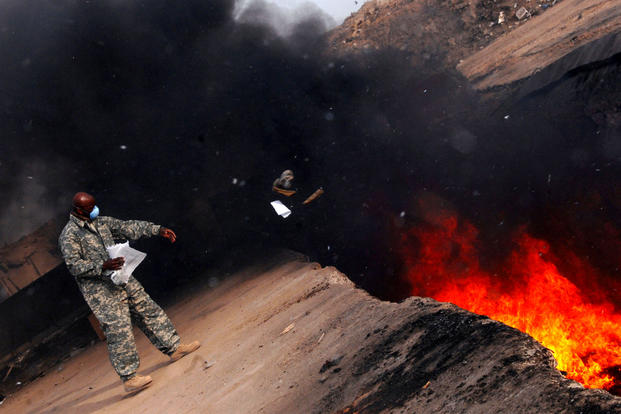Defense Department and Department of Veterans Affairs officials are meeting this week in Arlington, Virginia, for a two-day symposium on burn pits and airborne pollutants but, as with previous Joint VA/DoD Airborne Hazard Symposia, the meeting is closed to the public and press.
The symposium's purpose, according to documents from the first meeting in 2012, is to "provide an opportunity to discuss what we know, what we need to know and what can be done to study and improve care" for veterans and troops who "might have suffered adverse health effects related to exposure to airborne hazards, including burn pit smoke and other pollutants."
Attendance is tightly controlled, with Pentagon and VA officials convening to discuss topics such as a joint action plan to address potential health conditions related to exposure, the VA's Airborne Hazards and Burn Pit Registry, monitoring deployment environments and the impact of exposures on the Veterans Benefits Administration, according to a copy of the first day's agenda obtained by Military.com.
Members of several veterans service organizations and advocacy groups have been invited to speak, including the Veterans of Foreign Wars, Iraq and Afghanistan Veterans of America, Disabled American Veterans, American Legion, Burn Pits 360 and the Sgt. Sullivan Circle.
But those veterans' representatives are allowed to attend only a handful of sessions on the first day, March 14, including opening remarks and segments on outreach and education, as well as a brown-bag lunch during which they can discuss concerns and issues.
All events scheduled for March 15 remain unpublished.
Neither the VA nor the DoD responded to requests for information on the event. Veterans advocates also declined to discuss the meeting or their participation, with some expressing concern that they would be prevented from receiving future invites.
Thousands of troops serving in Iraq, Afghanistan and elsewhere were exposed to airborne pollutants while working and living near burn pits used to dispose of trash, medical waste and other types of refuse at area military bases.
Some have developed a chronic lung disease, constrictive bronchiolitis, while others have developed skin rashes, autoimmune disorders and various types of cancer, including glioblastoma, a brain cancer rarely seen in young adults, that they believe are related to burn pit exposure.
Veterans and advocates have pressed the VA for years to recognize these illnesses as related to burn pit exposure and want them to be considered "presumptive" conditions, a designation that would automatically qualify them for disability compensation and health services.
The VA says it lacks the scientific evidence to directly tie burn pit exposure to certain diseases but has granted service connection for several conditions associated with burn pits, deciding each claim on a case-by-case basis.
In 2011, the Institute of Medicine reviewed all available studies, reports and monitoring data on burn pit utilization and combustibles exposure and concluded that there was not enough evidence or data to draw conclusions about the long-term consequences of exposure.
More than 140,000 veterans have enrolled in the VA Burn Pit and Airborne Hazards Registry.
From June 2007 through Nov. 30, 2018, the VA received 11,581 claims applications for disability compensation with at least one condition related to burn pit exposure. Of those, 2,318 had a burn pit-related condition granted, according to VA Press Secretary Curt Cashour.
During the same time frame, the VA processed nearly 13.5 million claims; burn pit-related claims made up less than a tenth of a percent of those claims.
"VA encourages all veterans who feel their military service has affected their health to submit a claim, which will be adjudicated using the latest scientific and medical evidence available," Cashour said.
The Pentagon and VA are developing a way to track environmental exposures in service members starting with the day they enlist. The Individual Longitudinal Exposure Record, or ILER, will record potential and known exposures throughout a service member's time on active duty. A pilot program is set to begin Sept. 30.
But those who have suffered exposures in the past 30 years will need to rely on Congress to pass legislation to assist them, the Defense Department to continue researching the issues, and the VA to approve their claims.
Veterans of Foreign Wars, Vietnam Veterans of America, Wounded Warrior Project, IAVA, Disabled American Veterans, the Fleet Reserve Association, the Military Order of the Purple Heart and Military Officers Association of America all have made burn pit and toxic exposure issues a top legislative priority this year.
Several lawmakers, including Sen. Amy Klobuchar, D-Minnesota, and Rep. Tulsi Gabbard, D-Hawaii, have introduced legislation that would require the DoD and VA to share information on troops' exposure to airborne chemicals and provide periodic health assessments for those who were exposed.
The meeting is to take place at the Veterans Health Administration National Conference Center in Crystal City, Virginia.
-- Patricia Kime can be reached at Patricia.Kime@Military.com. Follow her on Twitter @patricia.kime.












